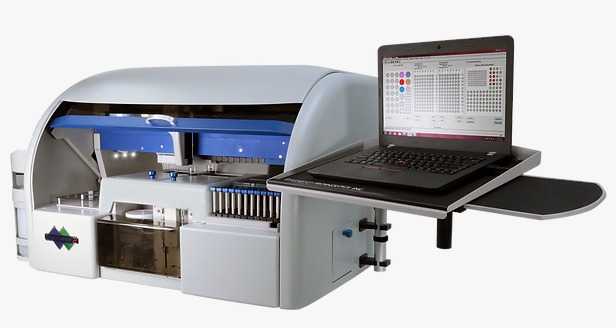Immunoassays are a cornerstone of modern diagnostics, research, and therapeutic monitoring, playing a vital role in various scientific and medical applications. By harnessing the specificity and sensitivity of the immune response, immunoassays can detect and quantify substances such as proteins, hormones, antibodies, and antigens. This article delves into the principles of immunoassays, their significance, and the different types available.
What are Immunoassays?
Immunoassays are biochemical tests that rely on the reaction between an antigen and its corresponding antibody. The core principle is based on the ability of antibodies to bind specifically to antigens, allowing for the detection and measurement of analytes in complex mixtures. This binding can be visualized or measured through various methods, resulting in either qualitative or quantitative data. InstaMed stands out as a premier ELISA Immunoassay Kits and Instruments Supplier in Dubai, providing top-tier solutions for accurate and reliable diagnostic testing.
Key Applications of Immunoassays
Medical Diagnostics: Detection of infectious diseases, monitoring of hormone levels, and identification of allergens. Pharmaceutical Research: Drug discovery, development, and monitoring of therapeutic levels. Food Safety: Detection of pathogens and allergens in food products. Environmental Monitoring: Detection of pollutants and toxins in environmental samples.
Types of Immunoassays
Immunoassays can be broadly categorized based on the type of detection used and the format of the assay. Below are the main types:
Radioimmunoassay (RIA)
Principle: Uses radioactive isotopes to label antigens or antibodies. Application: Often used in hormone and drug level measurement. Advantages: High sensitivity and specificity. Disadvantages: Involves handling radioactive materials, which require special facilities and disposal methods.
Enzyme-Linked Immunosorbent Assay (ELISA)
Principle: Uses enzymes linked to antibodies or antigens. The enzyme acts on a substrate to produce a detectable signal, usually a color change. Application: Commonly used for detecting viral infections, allergens, and hormones. Advantages: Non-radioactive, adaptable for high-throughput screening. Disadvantages: May require multiple washing steps and incubation periods. Variants: Includes Direct ELISA, Indirect ELISA, Sandwich ELISA, and Competitive ELISA.
Fluoroimmunoassay (FIA)
Principle: Uses fluorescent labels instead of enzymes or radioisotopes. Application: Suitable for applications requiring high sensitivity, such as detecting trace amounts of analytes. Advantages: High sensitivity and rapid results. Disadvantages: Requires specialized equipment to measure fluorescence.
Chemiluminescent Immunoassay (CLIA)
Principle: Involves chemiluminescent compounds that emit light upon reaction. Application: Used for detecting hormones, drugs, and proteins. Advantages: High sensitivity and dynamic range. Disadvantages: Requires specific equipment and careful handling of reagents.
Lateral Flow Immunoassay (LFIA)
Principle: Utilizes a test strip with antibodies immobilized on it. Commonly known as rapid tests or strip tests. Application: Widely used for point-of-care testing, such as pregnancy tests and infectious disease screening. Advantages: Simple, quick, and user-friendly. Disadvantages: Generally less sensitive compared to lab-based immunoassays.
Multiplex Immunoassay
Principle: Allows the simultaneous detection of multiple analytes in a single sample. Application: Useful in complex diagnostic panels, including allergen testing and autoimmune profiling. Advantages: High throughput and comprehensive analysis. Disadvantages: Requires sophisticated equipment and analysis.
Western Blot
Principle: Combines gel electrophoresis with immunoassay techniques to detect specific proteins. Application: Commonly used in research for protein analysis and in clinical settings for confirming HIV diagnosis. Advantages: Highly specific and provides molecular weight information. Disadvantages: Time-consuming and technically complex.
Immunohistochemistry (IHC)
Principle: Uses antibodies to detect antigens in tissue samples, often visualized with dyes or fluorescence. Application: Commonly used in pathology to diagnose diseases like cancer. Advantages: Provides spatial context within tissue samples. Disadvantages: Requires careful sample preparation and interpretation.
Radioallergosorbent Test (RAST)
Principle: Detects specific allergen-related antibodies using radioactive labels. Application: Used for allergy testing. Advantages: Specific and sensitive for allergen detection. Disadvantages: Involves radioactive materials.
Nephelometry and Turbidimetry
Principle: Measures the scattering of light by particles in a sample, often used to quantify immune complexes. Application: Common in the quantification of proteins like immunoglobulins. Advantages: Automated and suitable for large-scale testing. Disadvantages: May have limitations in detecting small changes in concentration.
Bioluminescent Immunoassay
Principle: Utilizes bioluminescent markers for detection. Application: Used in research and clinical diagnostics. Advantages: High sensitivity and reduced background interference. Disadvantages: Requires specialized equipment.
Electrochemiluminescent Immunoassay (ECLIA)
Principle: Involves electrochemiluminescent compounds for signal generation. Application: Used for precise quantification in clinical diagnostics. Advantages: High sensitivity, precision, and wide dynamic range. Disadvantages: Requires specific instrumentation and reagents.
Surface Plasmon Resonance (SPR)
Principle: Measures changes in light reflection associated with antibody-antigen binding on a sensor surface. Application: Used for kinetic studies and binding affinity measurement. Advantages: Real-time analysis and label-free detection. Disadvantages: Requires specialized equipment and expertise.
Magnetic Immunoassay
Principle: Uses magnetic particles as labels for detection. Application: Increasingly used in various diagnostic applications. Advantages: Sensitive and can be automated. Disadvantages: Requires specific magnetic detection equipment.
Immunoturbidimetric Assay
Principle: Measures the turbidity (cloudiness) of a sample as an indication of antigen-antibody complex formation. Application: Often used in automated clinical analyzers for protein quantification. Advantages: Simple and adaptable to automation. Disadvantages: Limited sensitivity compared to other methods.
Conclusion
Immunoassays are indispensable tools in modern science and medicine, providing critical insights into various biological processes and conditions. The choice of immunoassay depends on several factors, including the analyte of interest, required sensitivity and specificity, and available resources. As technology continues to advance, immunoassays will undoubtedly play an even more significant role in advancing diagnostics, research, and therapeutic monitoring.
Understanding the different types of immunoassays allows researchers and clinicians to choose the most appropriate method for their specific needs, ensuring accurate and reliable results. Whether for routine diagnostic testing or cutting-edge research, immunoassays are essential tools in the scientific arsenal.




